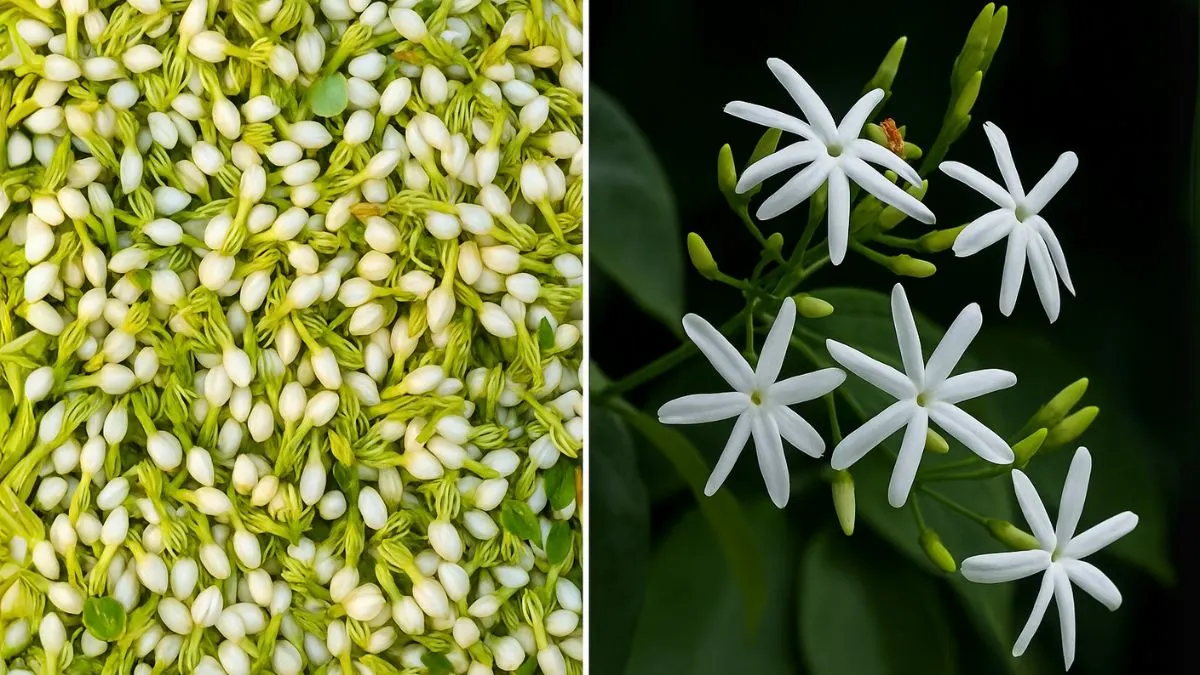There are flowers that look beautiful, and then there are flowers that define culture, history, and memory. The Juhi plant (Jasminum auriculatum) belongs to the second category. With its delicate, star-shaped white flowers and irresistible fragrance, this fragrant, evergreen flowering plant native to the Indian subcontinent has long held a special place in Indian traditions, gardens, and rituals.
From adorning the hair of brides to being offered in temples, Juhi has been more than just a plant—it has been a part of daily life. Let’s explore its types, care tips, cultural significance, and fascinating facts that make it so special.
What Makes Juhi Unique?

The Juhi plant is an evergreen plant with perennial flowers, meaning it keeps its green foliage year-round and continues to bloom season after season.
- Appearance: It is a bush-like shrub that blooms during late spring and summer, producing small yet extremely fragrant blossoms.
- Fragrance: Juhi is celebrated for its intoxicating scent, often described as calming and romantic.
- Growth: The plant thrives when it really demands ample sunlight. Gardeners often say that Juhi will only bloom abundantly if given full sunlight.
Interestingly, Juhi can be found in the Vandalur forest near Chennai, India, where it grows naturally alongside other indigenous species.
Cultural Significance of Juhi
Weddings and Festivals
Juhi flowers are often used in Indian weddings and festivals for their beauty and fragrance. Their pristine white blossoms symbolize purity, eternal love, and prosperity.
In traditional Indian ceremonies:
- Brides wear garlands of Juhi as a symbol of love and devotion.
- Temples use the blossoms in daily rituals as offerings to deities.
- Festivals such as Janmashtami often feature Juhi garlands to decorate idols.
This deep cultural bond makes it more than a garden plant—it is a living tradition.
Also Read: Grow the Exotic Desert Rose: More Than Just a Pretty Flower
Growing Conditions for Juhi
To grow Juhi successfully in your garden, certain conditions are crucial.
- Sunlight Needs
- The plant requires full sunlight for maximum flowering.
- While it can tolerate partial shade, it thrives best under bright light.
- Soil Preference
- A loamy, well-drained soil enriched with organic matter works best.
- Regular fertilization during the growing season enhances bloom quality.
- Watering
- Though hardy, Juhi prefers moderate watering—enough to keep the soil moist but not soggy.
- Climate
- Being a fragrant, evergreen flowering plant native to the Indian subcontinent, it thrives in warm, tropical, and subtropical climates.
Quick Care Guide for Juhi Plant
Factor |
Requirement |
Sunlight |
Full sunlight (minimum 5–6 hours daily) |
Soil |
Loamy, fertile, well-drained |
Watering |
Moderate; keep soil moist but not waterlogged |
Blooming Time |
Late spring and summer |
Growth Habit |
Bush-like shrub |
Benefits of Juhi Plant
Beyond its ornamental appeal, Juhi offers multiple benefits:
- Cultural Value
- Its use in Indian weddings and festivals makes it culturally priceless.
- Aesthetic Beauty
- Its star-shaped white flowers add elegance to gardens, courtyards, and balconies.
- Medicinal Uses
- In folk medicine, it has been associated with calming the senses and promoting relaxation. Its fragrance itself is considered therapeutic.
- Evergreen Nature
- Being an evergreen plant with perennial flowers, it ensures beauty throughout the year, not just in one season.
Also Read: Stachys Plant: Nature’s Soft Bandage With Healing Powers
Juhi in Global Gardening
While Juhi is rooted in Indian heritage, it’s slowly making its way into gardens in Canada, the USA, and other parts of the world.
Gardeners admire it because:
- It adapts well to pots and containers.
- Its fragrance stands out among other ornamentals.
- It symbolizes both prosperity and growth, making it a plant of positivity.
💡 Tip: If you live in a colder region, you can grow it in containers and bring it indoors during frost.
Propagation of Juhi
Juhi can be propagated easily through:
- Cuttings: Semi-hardwood cuttings root quickly in well-drained soil.
- Layering: A traditional method where stems are bent and covered with soil until roots develop.
- Seeds: Though less common, it can also be grown from seeds with patience.
This makes it accessible for beginner gardeners as well.
Personal Experience with Juhi
In my own garden, I once planted a Juhi shrub in a corner that received only three hours of sunlight. While the leaves thrived, flowers were few. The moment I shifted it to a spot with full sunlight, the plant transformed—blooming with clusters of star-shaped white flowers whose fragrance spread across the yard.
That experience taught me that while it is forgiving, it truly demands ample sunlight if you want to enjoy its full potential.
Also Read: Jasmine by the Door? It’s Not Just Pretty—It’s Powerful
Conclusion
The Juhi plant (Jasminum auriculatum) is far more than a simple shrub. It is a fragrant, evergreen flowering plant native to the Indian subcontinent, carrying cultural heritage, aesthetic beauty, and practical value. Its intoxicating scent, star-shaped white flowers, and use in Indian weddings and festivals make it timeless.
With the right care—especially ensuring full sunlight—this plant will not only thrive but also fill your home or garden with unmatched fragrance and positivity.
If you are looking for a plant that combines beauty, tradition, and resilience, Juhi is a perfect choice. Add it to your garden, and you’ll soon understand why it has been cherished for centuries.






